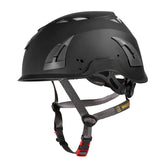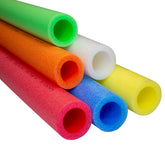Fall arrest lanyards help ensure the safety of our tradespersons working at height.
In essence, a fall arrest lanyard is a rope that connects a full body harness to an anchorage point, which has an inbuilt device to reduce the impact of a fall.
But degradation of the fall arrest lanyard is common and can occur for plentiful reasons. When this does happen, a lanyard can become too dangerous to use, essentially rendering it superfluous. From incorrect use and general wear and tear, to light, dirt, grit, and chemical damage, the failure of a fall arrest lanyard could result in potential injury of loss of life for the worker using it.
It is therefore the responsibility of the employer to ensure the correct and safe use of fall arrest equipment. Regular inspections and recertifications are critical to give confidence that fall arrest lanyards are safe to use.
What standards apply here?
According to the Health & Safety Executive (HSE)[1], The Personal Protective Equipment at Work Regulations 1992 requires employers to maintain fall arrest equipment in good repair, including appropriate replacements if required.
Further, the Work at Height Regulations 2005 state that equipment exposed to conditions causing deterioration which could result in dangerous situations should be inspected at suitable intervals, as well as each time exceptional circumstances that could negatively impact the safety of the equipment occur.
Added to that, the BS EN 365:2004 Personal protective equipment against falls from height standard states that in order to avoid fatal degradation, components should be examined at least every 12-months. That said, manufacturers of fall arrest lanyards usually recommend inspections more frequently than this. We at Leach’s certainly do.
It’s clear a lot of effort has been made to guarantee lanyard safety.
Who should conduct a fall arrest lanyard inspection?
When your fall arrest lanyards are due for inspection, it’s critical the inspector has the correct competencies to do so. That means they should have the relevant skills, knowledge, ability, and experience to conduct the necessary examinations, as well as the evidence to prove it.
Next, the competent person must also be independent and impartial. That means they can make objective decisions regarding the use of equipment. Often manufacturers and suppliers of height safety equipment will offer inspection services (as we do at Leach’s).
How do I know if my fall arrest lanyard is damaged?
According to the HSE, the following defects and damage could result in the weakening of a lanyard:
- Cuts of 1mm or more at the edges of webbing lanyards
- Surface abrasion across the face of the webbing and at the webbing loops
- Abrasion at the edges
- Damage to the stitching
- A knot in the lanyard, other than those intended by the manufacturer
- Chemical attach resulting in the weaking and softening of a lanyard – this can often be identified by flaking or a change of colour to the fibres
- Heat or friction damage – identified by fibres with a glazed appearance which may feel harder than surrounding fibres
- Heat or friction damage
- UV-degradation
- Partially deployed energy absorber
- Contamination by dirt, grit or sand which could lead to abrasion
- Damaged or deformed fittings
- Damage to the sheath and core of a kernmantel rope
- Internal damage to a cable-laid rope
A lanyard that has been used to arrest a fall should be withdrawn from use right away. Never reuse a lanyard.
Why we need inspections and recertifications
The responsible person for working at height during a project must provide a safe environment for workers. Unfortunately, that isn’t as simple as procuring the relevant equipment.
Rather, the focus should be on implementing an improved health & safety culture that permeates throughout the business. That means using the best equipment, encouraging regular training for your team regarding safety best practices when using equipment, and ensuring all safety equipment is regularly inspected and serviced so we can reduce the number of accidents on site. After all, if an accident does occur and it’s found that equipment wasn’t properly maintained, it is the controller of the work that is liable.
We’ve got you covered
If you need qualified and competent professionals to undertake your inspections and re-certifications, Leach’s can help.
We offer reliable fall arrest lanyard inspections, servicing, and re-certification services, which can also be applied to a range of other height safety equipment. We’re here to help you ensure your equipment is kept in full working order so you and your team can continue safely working at height.
We aim to make the service as easy and accessible as possible to make sure as many users as possible can benefit from safe equipment when working at height. That’s why we can also arrange to collect and deliver your height safety equipment back to you, fully re-certified!
Sound good? For more information about our inspection, servicing and re-calibration service, click the link. Alternatively, call our sales team on +44 (0)1432 346890 or email sales@leachs.com.
[1]INDG367 - Inspecting fall arrest equipment made from webbing or rope (hse.gov.uk)


















